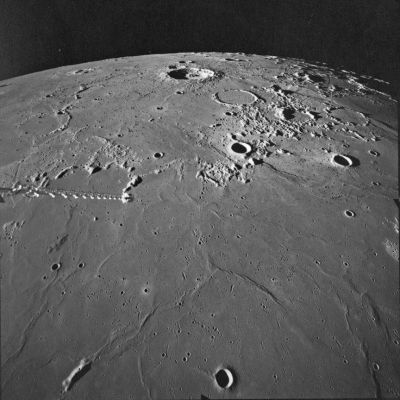Mare Cognitum
Mare Cognitum (impact site of Ranger 7 and Apollo 14's SIVB stage)
|
Lat: 10.0°S, Long: 23.1°W, Diam: 376 km, Depth: km, Rükl: 42 |

Apollo 16 AS16M-2493
Southward oblique Fairchild-camera view of the southern part of Mare Cognitum.
The big crater near the curved horizon is Bullialdus. The small bowl-shaped crater near the bottom of the frame is Kuiper. The elongated hill near the frame's lower left corner is Bonpland Omega, very near the impact site of Ranger 7.
Images
LPOD Photo Gallery Lunar Orbiter Images Apollo Images
Ranger 7 - Camera A photographs
Ranger 7 - Camera B photographs
Ranger 7 - Camera P photographs
Maps
(LAC zone 76D2) LAC map Geologic map LM map LTO map
Description
Mare Cognitum; “the sea that has become known”, with a diameter of 376 km (10.0 S 23.1 W), is located in a basin that sits within the proposed second ring of the Procellarum basin. The mountain range Montes Riphaeus to the northwest of the region may represent part of the rim-crest of a large buried crater, containing the mare. It's very strange, to see no continuing rim of the large Riphaeus crater on chart SLC E5 (System of Lunar Craters, 1966). Don Davis made interesting paintings of the violent Riphaeus event (the creation of the large impact crater) for Carl Sagan's book COSMOS.
Description: Wikipedia
The space age
A number of spaceflight missions visited this region: Apollo 12 landed close to Surveyor 3, and Apollo 14 landed on the hills at the edge of the Fra Mauro crater. Mare Cognitum is also the location where Ranger 7 and the SIVB stage of Apollo 14 crash-landed.
Ranger 7 in the eastern part of Mare Cognitum
- The impact-craterlet of Ranger 7 is described and depicted in APOLLO OVER THE MOON (Craters, Part 2), Figure 122.
- The two hillocks Bonpland Gamma and Bonpland Omega (north of Ranger 7's impact site) are described and depicted in Chapter 4: The Maria (Part 2), Figure 69.
Apollo 14's impacted SIVB stage in the western part of Mare Cognitum
- The artificial craterlet and surrounding ejectablanket of Apollo 14's impacted SIVB stage is described and depicted in NASA SP-362, APOLLO OVER THE MOON; A VIEW FROM ORBIT, Chapter 5: Craters (Part 2), Figures 120 and 121.
- On the LRO's ACT-REACT Quick Map, the impact craterlet of Apollo 14's SIVB stage is detectable at LON: -26.032, LAT: -8.18 (0.5 M/PIX).- DannyCaes Jul 3, 2011
- The dark ejectablanket of Apollo 14's impacted SIVB stage is also seen on Lunar Topographic Ortophotomap 76-D1 (8°10' South/ 333°57')(26°03' West).
- On orbital image AS16-M-2518, which is included in the book FULL MOON by Michael Light and Andrew Chaikin (Plate 25), is the dark ejectablanket of Apollo 14's impacted SIVB stage also detectable! You need a good magnifying glass and the exact location of the ejectablanket, via LTO map 76-D1. Believe it or not, Danny Caes detected the ejectablanket on the printed version of that photograph in FULL MOON!
Nomenclature
- Mare Cognitum: "Sea that has become known", thanks to the Ranger VII impact site.
- Name proposed by Gerard P. Kuiper who was a Ranger PI (see also E.A.Whitaker's Mapping and Naming the Moon, page 174: "Kuiper suggested a choice between Mare Exploratum or Mare Cognitum. After considerable discussion, the second of these (the Known Sea, or The Sea That Has Become Known) received the vote").
- In the western part of Mare Cognitum is a wrinkle ridge which was once called the Jekaterinburg Damm by Johann Nepomuk Krieger and Rudolf Konig.
- Another interesting fact is the close proximity of Apollo 14's SIVB impact area near Krieger's Jekaterinburg Damm and the bowl-shaped crater Euclides D.
LPOD Articles
Bibliography
- Bugiolacchi, R, PD Spudis & J Guest (2004) Lava flows in Mare Nubium and Mare Cognitum. Lunar & Planet. Sci. 35, 1507.
- Hiesinger, HH, JW Head, U Wolfe, R Jaumann & G Neukum (2003) Ages and stratigraphy of mare basalts in Oceanus Procellarum, Mare Nubium, Mare Cognitum, and Mare Imbrium. J. Geophys. Res. 108, E7, 5065, doi:10.1029/2002JE001985, 2003.
- Krieger's and Konig's "Jekaterinburg Damm": MAPPING AND NAMING THE MOON, Ewen A. Whitaker (pages 164 and 226).
- APOLLO OVER THE MOON; A VIEW FROM ORBIT, Chapter 2: Regional views, Figure 26. Chapter 4: The Maria (Part 3), Figure 91.
- THE MOON CLOSE-UP (Ranger 7), by Eugene M. Shoemaker (NATIONAL GEOGRAPHIC november 1964, pages 690 to 707).